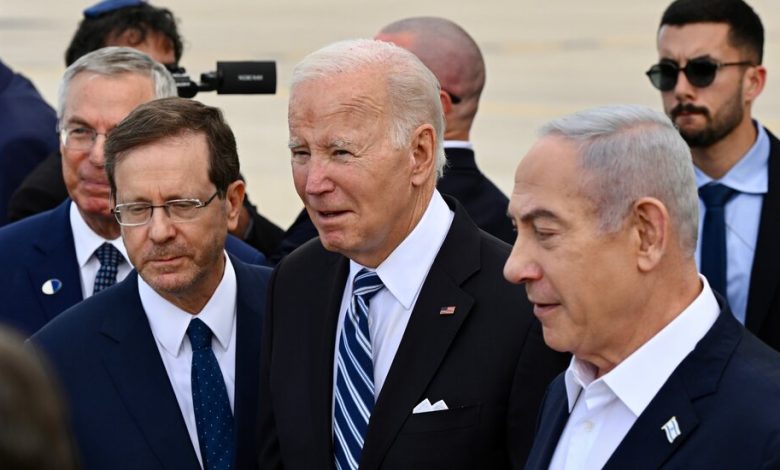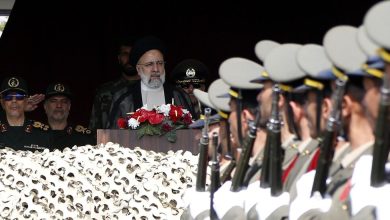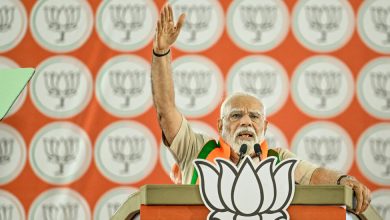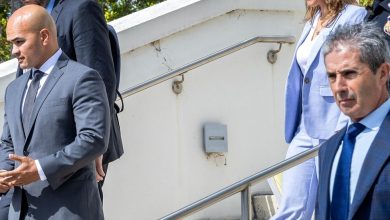The U.S. and Israel: An Embrace Shows Signs of Strain After Oct. 7

President Biden was getting ready to leave the White House for an audacious flight to Israel to demonstrate solidarity after the Oct. 7 terrorist attack when suddenly the trip seemed to be falling apart before it even began.
An explosion at a Gaza hospital had reportedly killed or wounded hundreds, the Palestinians were blaming Israel, and Arab leaders were refusing to meet with Mr. Biden when he arrived in the region. The president summoned advisers to the Treaty Room on the second floor of the White House family quarters to answer the question: Should he still go?
A robust debate broke out between his national security and political advisers. Some in the room urged Mr. Biden to scrap the trip. It was not clear what could be accomplished. It might not even be safe. What if Hamas launched rockets at Ben-Gurion International Airport when Air Force One approached? Where would the president land then?
Others argued that he needed to go anyway. He had already announced the visit. They should not lurch from one decision to another. And preliminary U.S. intelligence indicated that Israel was not responsible for the hospital explosion.
Finally, Mr. Biden weighed in. “I’ve got to go,” he said. “I’ve got to see these guys face to face.”
That decision, perhaps more than any other, would come to define Mr. Biden’s approach to what has become the most divisive foreign policy crisis of his presidency. He had to go. He had to see them face to face. With that, he effectively took ownership of the war that would follow in all its overpowering brutality, managing it personally at great political risk to himself at home and abroad.
No other episode in the past half-century has tested the ties between the United States and Israel in such an intense and consequential way. The complicated diplomacy between Washington and Jerusalem since Hamas terrorists killed 1,200 people and seized 240 hostages has played out across both governments, in direct interactions between the leaders and intense back and forth between military and intelligence agencies.
The resolve of that dramatic presidential trip to Israel has given way to frustrating phone calls, sharp public comments and exhausting marathon meetings. The relationship has grown increasingly fraught as Mr. Biden has involved himself more intensely in the conflict than almost any other issue in three years in office. The president and his team have intervened time and again to steer Israel away from what they consider the excesses of its retaliation only to have the Israelis defy them at critical moments.
Mr. Biden has seen growing internal resistance to his backing of Israel, including multiple dissent cables from State Department diplomats. In November, more than 500 political appointees and staff members representing some 40 government agencies sent a letter to Mr. Biden protesting his support of Israel’s war in Gaza. Congressional Democrats have been pressing him to curb Israel’s assault, and the United States has found itself at odds with other countries at the United Nations.
The friction appears to be coming to a head as the new year arrives. The Biden team recognizes that its challenge is not just Prime Minister Benjamin Netanyahu, since Israelis across the board support the military operation that according to the Gaza Health Ministry has killed more than 20,000 people. But there is no serious discussion inside the administration of a meaningful change in policy, like cutting off the arms supply to Israel. Instead, Mr. Biden remains determined to navigate the crisis within the crisis by using the credibility he earned through steadfast support of Israel to shape its next chapter, although it is unclear how much leverage that gives him.
During a tense conversation a week ago, Mr. Biden pressed Mr. Netanyahu to scale back the war to a surgical operation relying more on special forces raids targeting Hamas leaders and tunnels than wide-scale bombing. The Israeli leader then sent his right-hand adviser, Ron Dermer, to Washington for what ended up being a nearly four-hour meeting at the White House the day after Christmas, where he assured Secretary of State Antony J. Blinken and Jake Sullivan, the national security adviser, that Israel would soon shift to the targeted phase that Mr. Biden has been urging.
The first signs of such a shift could be seen in the coming weeks as Israeli forces wrap up operations in northern Gaza and begin withdrawing many troops from that area, Mr. Dermer told them. But he did not give a firm timetable, and the Americans pressed him to begin the transition sooner rather than later. Mr. Blinken plans to head back to Israel in early January, when Israeli officials hope to give him a decision on next steps
At the same time, Mr. Biden’s team has been quietly working to negotiate a new hostage deal. William J. Burns, the C.I.A. director, met with his Israeli counterpart and Qatar’s prime minister in Warsaw earlier in December to advance a proposal for a seven-day halt to the fighting in exchange for the release of another 35 to 40 people seized on Oct. 7, including civilian women, badly wounded men and other men over 60 years old.
And there are even quieter efforts underway to negotiate through intermediaries an arrangement with Hezbollah to pull back from the area near Lebanon’s border with Israel, preventing the eruption of a wider war in the region and allowing tens of thousands of Israelis who have fled their homes to return.
This account of the relationship between the United States and Israel over the past 12 weeks is based on multiple interviews and trips to the region with key American and Israeli officials, who spoke on the condition of anonymity to share details of internal conversations and deliberations. It is a complicated story where officials on both sides say public assumptions do not always match the private reality.
Fears of a Wider War
The first week after the attack was the most volatile and dangerous. Mr. Biden’s biggest fear, according to advisers, was an expanded war in which Iran would empower proxies in addition to Hamas to attack Israel, or Israel would launch a pre-emptive war against such forces.
As he learned about the attack on Oct. 7, Mr. Biden conducted three conference calls and three in-person meetings with his national security team, delivered a statement to the media and made separate calls to Mr. Sullivan; Jon Finer, his deputy national security adviser; Mr. Netanyahu; King Abdullah II of Jordan; Vice President Kamala Harris; Defense Secretary Lloyd J. Austin III; and two congressional Democrats who were in Israel, Senator Cory Booker of New Jersey and Representative Dan Goldman of New York.
He would go on to send a steady procession of officials to the region. Mr. Blinken has made three trips to the area with five stops in Israel, once even joining a meeting of Israel’s war cabinet. Others who have traveled to the region include Ms. Harris; Mr. Austin; Mr. Burns; Mr. Sullivan; Brett McGurk, the president’s Middle East coordinator; Avril D. Haines, the director of national intelligence; Gen. Michael E. Kurilla, the head of U.S. Central Command; and Lt. Gen. James Glynn, who led Special Forces against the Islamic State.
Mr. Biden has now spoken directly with Mr. Netanyahu 14 times, in addition to calling the leaders of Egypt, Saudi Arabia, Qatar, the United Arab Emirates and Oman, as well as Pope Francis. Every presidential call with Mr. Netanyahu typically involves a preliminary meeting with Mr. Biden’s advisers and a debriefing afterward. Mr. Dermer then often calls Mr. Sullivan for another hourlong discussion.
On Oct. 11, Mr. Biden made an urgent call to Mr. Netanyahu. The Israelis had gotten vague intelligence that Hezbollah was about to launch a major strike against Israel, and the Israelis, pushed by Defense Minister Yoav Gallant, were preparing to strike first. The Americans got wind of the situation but believed the intelligence was not so clear.
Joined by Mr. Blinken and Mr. Sullivan, Mr. Biden spoke with Mr. Netanyahu and other Israeli officials to press them not to attack. If you do this, the Americans argued, you will guarantee the very thing we think we can prevent and deter. The Israelis agreed to back down. Mr. Biden, who had already sent one carrier group to the eastern Mediterranean to deter Hezbollah from joining the fray, sent a second one.
American officials began racing to Israel, first Mr. Blinken, then Mr. Austin. On Oct. 13, Mr. Austin privately warned Mr. Gallant that the Israelis needed to establish humanitarian corridors and a defined set of rules to protect Palestinian cities, citing America’s experiences with urban warfare in Iraq.
Mr. Blinken spent a week traveling around the region, briefing the president each day by secure line. On one day alone, he conducted nine hours of talks with the Israelis, and at one point was forced to evacuate during a rocket attack to an underground bunker six floors beneath the surface. Mr. Blinken and his aides sat in one room while Mr. Netanyahu and his war cabinet sat in another. Mr. Netanyahu shuttled back and forth between the rooms, listening to American proposals and bringing them back to his team. He agreed to let humanitarian aid into Gaza as a condition for Mr. Biden visiting.
Mr. Biden’s advisers and allies said his personal involvement has averted a broader war and influenced Israel’s approach, even if not as much as he would hope.
“He’s had some impact,” said Senator Chris Coons, a Democrat from Delaware and a member of the Foreign Relations Committee. “He’s been able to move their decisions. But he has embraced Israel in this moment of intense pressure following a terrorist attack because he sees this moment in a regional context and is trying to achieve peace in a regional way.”
While Israeli officials bristle at the constraints Mr. Biden has tried to impose on them, they recognize that he is the most important ally they have amid rising global criticism and understand that he is the only thing stopping the United Nations from imposing sanctions.
“We are deeply appreciative of the support of the Biden administration to Israel in this war and in these difficult days,” said Michael Herzog, the Israeli ambassador to Washington. “We have a very close and productive dialogue between our two governments as regards this war.”
‘Weeks, Not Months’
The Americans were not impressed with the original Israeli plan for a ground invasion of Gaza and sought to temper it. But the Israelis ultimately unleashed more firepower on Gaza than even the Biden team expected, with deadly results. Pictures of dead Palestinians outraged not only many in Mr. Biden’s own party but in his own administration and even his own White House.
Mr. Biden kept up a steady stream of phone calls to Mr. Netanyahu, pushing to minimize civilian casualties. Qatar, the Persian Gulf emirate that is friendly with both the United States and Hamas, secretly told Mr. Blinken when he visited on Oct. 13 that Hamas was ready to offer a hostage release for some sort of cease-fire or pause. Mr. Biden assigned a small circle of officials to clandestinely negotiate what ultimately became a one-week pause in fighting in exchange for more than 100 captives.
Mr. Biden kept calling and calling. When he was in his limousine, known as “the Beast,” heading to an unrelated event, the president would pick up the phone to check on the latest. When his meeting in November with China’s president, Xi Jinping, in California broke for lunch, he huddled with Mr. Sullivan to ask for updates in the hostage talks. The four hours he spent with Mr. Xi that day was the most waking time Mr. Biden had spent to that point out of touch with the Middle East.
The pressure-cooker intensity has taxed even a team already tested by the U.S. withdrawal from Afghanistan and Russia’s invasion of Ukraine. Mr. Sullivan has talked about being focused hour by hour on the war and losing sleep over what unexpected events might come next. Mr. Finer came up with a stock answer to the question of whether he was getting any sleep at all. “Yes,” he would say, “almost every day.”
When the weeklong pause ended and Israeli bombs began falling again, the Americans once more urged restraint. But Mr. Biden’s advisers were sympathetic to the Israelis, who were discovering a network of Hamas-built tunnels even more extensive than imagined — essentially multistory buildings some hundreds of feet underground, requiring massive bombardment to damage or destroy. The Israelis referred to the catacomb of tunnels as “the Kingdom.”
The sharpest dispute between Washington and Jerusalem centered on the “day after” question — what to do in Gaza after the war ends. Mr. Netanyahu has resisted Mr. Biden’s suggestions that a “revitalized” Palestinian Authority, which is based in the West Bank, run a post-Hamas Gaza to be followed eventually by establishment of a Palestinian state.
Mr. Netanyahu focused especially on the failure of Palestinian Authority leaders to denounce the Oct. 7 attack, worried that granting them a future role would be seen as weakness by his right-wing coalition. Shortly before Mr. Blinken arrived for his fifth visit, Israeli media reported that Mr. Netanyahu had told allies he was the only thing standing between them and Mr. Biden’s two-state solution.
During meetings in Jerusalem on Nov. 30, Mr. Blinken privately told the Israeli war cabinet that it had “weeks, not months,” to wrap up combat operations at the current level of intensity, a comment later leaked to Israeli media and confirmed in recent days by U.S. officials. A defiant Mr. Netanyahu said publicly after Mr. Blinken left that “we will continue the war until we achieve all its goals.” Mr. Austin the same day warned in a speech in California that Israel could “replace a tactical victory with a strategic defeat” if it drove Palestinian civilians into the arms of Hamas.
Mr. Biden remained committed to Israel. When Israeli officials made an urgent plea for more tank ammunition, prompting a U.S. government process that would typically take months, the Biden administration cleared it almost immediately. At 11 p.m. on Dec. 8, the State Department notified Congress that it would bypass congressional processes to send 13,000 rounds to Israel, infuriating some Democratic lawmakers. As of mid-December, the United States had also shipped about 20,000 air-to-ground munitions to Israel, according to internal U.S. government reports.
But the president was growing frustrated, too. During a fund-raiser on Dec. 12, he warned that Israel risked losing international support “by the indiscriminate bombing that takes place.” It was not a scripted comment and sent aides scrambling to explain, but it pleased some administration officials who believed Mr. Biden had been too reluctant to publicly criticize Israel.
At the president’s direction, Mr. Burns, the C.I.A. director, embarked on a mission to broker the release of more hostages, including a handful of Americans still being held. His meeting in Warsaw on Dec. 18 en route back from a trip to Ukraine was the product of weeks of intense calls with David Barnea, the director of Israel’s Mossad spy agency, and Mohammed bin Abdulrahman bin Jassim Al Thani, the Qatari prime minister. Mr. Burns sometimes spoke with Mr. Barnea three times a day and just as often with Qatari officials.
But the proposal Mr. Burns and Mr. Barnea offered the Qataris in Warsaw has yet to lead to a deal. For Hamas, the price seems to have gone up. American officials believe Hamas does not want to release more hostages for a temporary pause but instead is holding out for a permanent cease-fire. Israeli officials have told American counterparts that one reason they publicly resist pressure to ease their military campaign is to maintain pressure on Hamas to release hostages.
‘A Pipe Dream’
The recent conversations between Mr. Biden and Mr. Netanyahu have grown more strained. Every call is tense and sometimes sharp, officials say, but at the same time matter of fact. Difficult but constructive is the phrase often used. The tone described by insiders has been along the lines of, “Look, man, you’ve got to do more about this or take this more seriously.” The two men have known each other for decades and are not truly friends, but understand each other’s politics and their mutual dependence at this point.
The Americans recognize that Israelis remain so traumatized by Oct. 7 that there is nearly universal support across the political spectrum for the toughest action against Hamas and little concern about possible consequences. And strategically, Israel does not mind too much if the rest of the world thinks it is willing to go overboard with overwhelming force. It survived the half-century since its 1973 war with its Arab neighbors by fostering the image of invincibility, an image shattered on Oct. 7. Israeli leaders want to reestablish the deterrence that was lost.
As for Mr. Biden’s team, the real debate is about the language to use and how hard to push, but no one inside is really pressing for a dramatic policy shift like suspending weapons supplies to Israel — if for no other reason than they understand the president is not willing to do so.
The administration’s message has four parts: Israel has a right to self-defense, Hamas must be removed as a threat, humanitarian aid needs to be increased and civilian casualties should be minimized. While some officials emphasize the latter points, the president in public has typically stressed the first ones.
Mr. Biden got on the phone with Mr. Netanyahu on Saturday, Dec. 23, to urge Israel to pivot away from intense military action toward a more targeted approach of raids against specific locations. But Mr. Netanyahu and other Israeli leaders continued to push back publicly. Two days later, Mr. Netanyahu published an opinion essay in The Wall Street Journal dismissing the notion that the Palestinian Authority could demilitarize Gaza as “a pipe dream.”
For Israeli officials, there is pressure to reassure their public that they are not backing off. But there are hints that Mr. Netanyahu could ultimately accept a role for a reformed Palestinian Authority in Gaza, recognizing there needs to be a Palestinian administration of sorts even as they hope to persuade Gulf Arab states to pay for reconstruction.
For all the disagreement, there is no serious discussion within the Biden administration about cutting Israel off or putting conditions on security aid. On Friday, three days after the Dermer meeting, the State Department agreed to send $147.5 million in 155-millimeter artillery shells and related equipment, invoking emergency rules to bypass congressional review a second time and again angering Democratic lawmakers.
To the extent that Mr. Netanyahu’s resistance to American entreaties is performative politics for a domestic audience, it also has a time limit, according to Martin S. Indyk, a former two-time American ambassador to Israel.
“It’s a case of steady insistence that Bibi come around,” he said, referring to Mr. Netanyahu by his nickname. “That’s what we’re witnessing. I’m quite confident in predicting that Bibi will do so in the new year. He just has to figure out a way of explaining to his coalition partners that while it might look like he’s giving into Biden, he’s not really doing so. There will be a lot of winking going on.”
Michael B. Oren, a former Israeli ambassador to Washington, noted that despite the tension, Mr. Biden has not used the two most obvious tools available to him to force Israel’s hand, namely the flow of U.S. arms to Israel and the U.S. veto at the U.N. Security Council that protects Israel from international sanctions — at least not yet.
Given that, Mr. Oren said, Israel appreciates Mr. Biden’s support and does not want to alienate him. The Oct. 7 attack undercut Israel’s longstanding mantra that it would defend itself by itself. “That meant whether we liked it or not, we were dependent on the United States,” he said. “And that meant they have a say in things.”
Reporting was contributed by Helene Cooper, Eric Schmitt and Michael Crowley from Washington, and Ronen Bergman from Tel Aviv.



